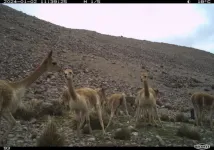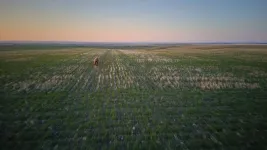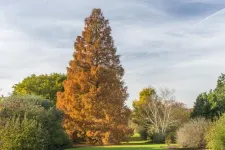(Press-News.org) Climate change is melting away glaciers around the world, but in the Andes Mountains, a wild relative of the llama is helping local ecosystems adapt to these changes by dropping big piles of dung.
This finding, published Dec 30 in Scientific Reports, revealed that the activity of this animal could accelerate the time plants usually take to establish on new land by over a century, highlighting a surprising way organisms are adapting to climate change.
“It’s interesting to see how a social behavior of these animals can transfer nutrients to a new ecosystem that is very nutrient poor,” said Cliff Bueno de Mesquita, the paper’s co-first author and a research scientist in the Cooperative Institute for Research in Environmental Sciences at CU Boulder. But the current pace of climate change still outpaces the ability of species to find new habitats, he warned.
The changemakers here are the vicuñas. They are one of two wild South American camelids, a group of animals that includes alpaca and llama, which are domesticated species. They live in the high alpine areas of the Andes.
Vicuñas may be less famous than their celebrated llama cousins, but they are no less remarkable, particularly because of where they choose to poop.
Much like how humans use bathrooms, these animals get rid of their solid waste using a designated spot shared by multiple members of a social group. Scientists refers to these communal dung piles as latrines.
Over the past two decades, Steven Schmidt, the paper’s senior author and professor in the Department of Ecology and Evolutionary Biology, has studied how microbial life and plants are responding to retreating glaciers in the high-altitude Peruvian Andes.
The deglaciated soils are extremely depleted of nutrients and water—a sea of rocks and gravel that can remain plant-free for over a century.
But during expeditions over the last ten years, Schmidt and his collaborators began noticing patches of plants, all of which seemed to have emerged from vicuña poop piles.
Working with animal ecologist Kelsey Reider at James Madison University, the team trekked to sites in the Peruvian Andes, up to 18,000 feet above sea level, that were previously covered by glaciers. They sampled vicuña latrine soils in these areas and found that, compared to barren soils just a few feet away, soils with vicuña poop contained significantly more moisture and key nutrients, like organic carbon, nitrogen and phosphorus.
For example, latrine soil was made of 62% organic matter. In contrast, deglaciated soil that has been exposed for 85 years at the same location but without latrines contained only 1.5% organic matter.
At high elevations, temperatures tend to fluctuate significantly throughout the day, dropping below freezing every night even during the summer. “It's really hard for things to live, but that organic matter made it so that temperatures and moisture levels didn't fluctuate nearly as much. The latrines created a different microclimate than the surrounding area,” Schmidt said.
The team also found high DNA concentrations and a wide diversity of microorganisms in latrine soil samples, suggesting that the latrines provided vital ground for microbes and plants to thrive.
The team said vicuña dung likely accelerated the timeline for plants to colonize a barren, lifeless habitat by a century. These animals deposit nutrients and plant seeds from lower elevations in their poop onto deglaciated ground, and then the seeds germinate, attracting other organisms, including animals that feed on the plants.
Camera footage showed that the patches of plants have attracted all kinds of animals, including rare species never before seen at such high elevations and large carnivores like puma. Vicuñas also eat the vegetation growing in their own latrines.
It could take hundreds of years for the deglaciated area to transition into grassland, which might help mitigate the negative impacts that many species preferring colder climates face as their habitats shrink from climate change, Reider said.
But even with the vicuña’s help, the rate of species colonizing new ground is much slower than the rate at which the glaciers are retreating.
Glacier melt across the world has accelerated over the past two decades. Between 2000 and 2019, glaciers other than the Greenland and Antarctic ice sheets lost about 267 billion tons of ice each year. If warming continues, the Earth could lose 68% of its glaciers, a prior study estimated.
In parts of the Andes and other mountain ranges, including the Rocky Mountains, many people depend on mountain snow and glacier runoff for water. It is estimated that shrinking glaciers and snow cover could threaten the water supply for nearly a quarter of the world’s population.
“The vicuñas are probably helping some alpine organisms, but we can’t assume they’ll all be okay, because in Earth’s history, we’ve never seen climate change happen at this speed,” Bueno de Mesquita said. “Current anthropogenic climate change is probably the most severe crisis our planet and all living things have faced in the past 65 million years.”
END
How animal poop helps ecosystems adapt to climate change
2025-01-27
ELSE PRESS RELEASES FROM THIS DATE:
Over 1/3 of parents say their child has experienced dental problems that reflect oral hygiene habits
2025-01-27
More than one in three parents say their child has faced issues like tooth decay, cavities, stained teeth, gum concerns or tooth pain over the past two years, a national poll suggests.
And these problems were linked to children’s oral care routine, more commonly experienced among those who skipped dental hygiene recommendations or followed them less often, according to the University of Michigan Health C.S. Mott Children’s Hospital National Poll on Children’s Health.
“Maintaining oral health from a young age, including regular brushing ...
Colorado’s parental notification law can impede adolescent access to abortion, study says
2025-01-27
AURORA, Colo. (Jan. 27, 2025) – A new study led by researchers from the University of Colorado Anschutz Medical Campus has shed light on the burdens parental involvement laws impose on adolescents seeking abortion care, even in states like Colorado where abortion is protected. Researchers say these laws contribute to logistical barriers, heightened stress and delays in accessing care, disproportionately impacting vulnerable populations.
The study, published today in the Journal of Adolescent Health, analyzed the experiences of adolescents (ages 15-17) and young adults (18-22) who either sought or ...
Drones could be the ‘magic tools’ we need to chase bears away from people
2025-01-27
Brown bears roam across much of the northern hemisphere from the mountains of Spain to the prairies of the US. These bears are formidable carnivores that can weigh up to 751 kg (1,656 lb) and have claws 15 cm (6 in) long. With long canine teeth and a bite force of 6,800,000 pascals (1,000 psi), these bruins can easily crush bones. All these powerful features make brown bears an imposing predator that can take down prey as large and dangerous as an adult bison. Yet, while these bears eat meat, much of their diet is plant-based because they are omnivores. Brown bears have very few dietary restrictions. They are certainly not gluten intolerant ...
Rethinking altruistic punishment: New experimental insights
2025-01-27
How would you react if someone cut in line behind you? Some people will warn others to follow the rules, even if it does not affect them. This is known as altruistic punishment, the act of punishing others for selfish behavior without reciprocal benefit.
Previous studies on altruistic punishment often placed participants in unnatural settings where they were compelled to observe the selfishness of others and decided whether to punish them. In reality, there are times when avoidance of such a situation takes precedence over confronting unfairness. In other words, a person could pretend they did ...
Move more, age well: Prescribing physical activity for older adults as a recipe for healthy aging
2025-01-27
Can physical activity extend the lifespans of older adults? A review article published in CMAJ (Canadian Medical Association Journal) https://www.cmaj.ca/lookup/doi/10.1503/cmaj.231336 summarizes the considerable evidence supporting the important role physical activity plays in preventing or reducing the effects of diseases and discusses how to prescribe effective exercise for older adults.
Canada’s population is aging, with at least 1 in 5 people aged 65 years or older in 2025, and the number of people older than age 85 years is expected to triple in the next 20 years. However, for many people, ...
Botanic Gardens must team up to save wild plants from extinction
2025-01-27
A major study of botanic gardens around the world has revealed their struggles with one fundamental aim: to safeguard the world’s most threatened plants from extinction.
Researchers analysed a century’s worth of records - from 1921 to 2021 - from fifty botanic gardens and arboreta currently growing half a million plants, to see how the world’s living plant collections have changed over time.
The results suggest that the world’s living collections have collectively reached peak capacity, and that restrictions ...
Approaching the red planet from the kitchen
2025-01-27
Niigata, Japan - Rootless cones are small volcanic landforms ranging from several to several hundred meters in diameter, formed by continuous explosions resulting from the interaction between surface lava and water bodies like lakes and rivers (Figure 1). Unlike regular volcanoes originating from magma rising from deep underground, rootless cones form when lava covers a water-containing layer, triggering explosive reactions. Due to this process, they are also called pseudocraters. While Iceland hosts many rootless cones, they ...
How Camellias evolved with the formation of the Japanese archipelago?
2025-01-27
Niigata, Japan – The distribution of plants has been shaped by geological and climatic changes over time through repeated migration, extinction, and adaptation to new environments. The genus Camellia, comprising over 100 species mainly in East Asia, is a representative warm-temperate tree of the Sino-Japanese Floristic Region.
In Japan, four species of Camellia are found, with Camellia japonica and Camellia rusticana being the most well known. C. japonica has a broad distribution from Aomori Prefecture in the cool-temperate ...
Study succeeds in the early diagnosis of leptomeningeal disease in diffuse midline gliomas by liquid biopsy
2025-01-27
Niigata, Japan – A group led by the Department of Neurosurgery, Brain Research Institute, Niigata University succeeded in the diagnosis of leptomeningeal disease in diffuse midline gliomas by detecting H3K27M-mutant droplets from circulating tumor DNA of cerebrospinal fluid taken from these patients. In two patients, leptomeningeal disease was diagnosed earlier than with traditional methods such as MRI and cerebrospinal fluid cytology. In one patient, long term survival after the diagnosis of leptomeningeal disease by early ...
Understanding the science of meaty flavors could be key to sustainable diets, says academic
2025-01-27
Understanding the science behind meaty tastes and textures could be the key for more people switch to a planet-friendly plant diet, researchers suggest.
Ole G. Mouritsen, a professor of gastrophysics, addresses the urgent need to make changes to culinary cultures where animal-based proteins play a central role.
Replicating a little-known meaty flavour and a sensation of richness could encourage more plant-based eating, he explains.
“To ensure that there is enough food for a growing world population, to lessen the burden on the environment, and to promote healthier, sustainable eating patterns, it ...






